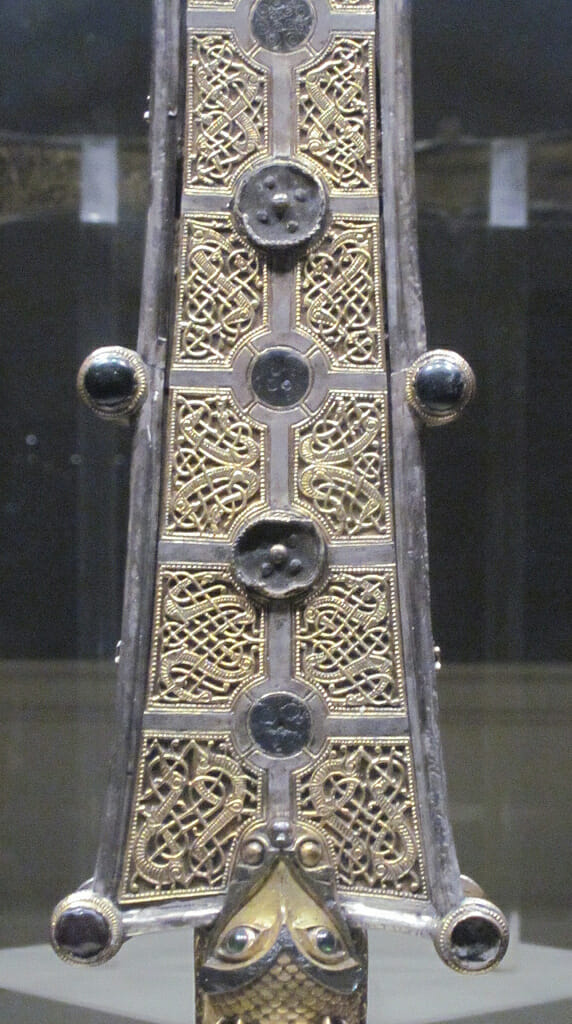Similar Posts

Casket Reliquary, designed and carved by the author. 26 steatite stone miniatures set into a bubinga box made by Andrew Gould.
There are certain Medieval forms which have always been with me, seeming to affect an almost hypnotic attraction. The casket reliquary or “chasse” is one of these. Shaped like a tomb, but also suggesting a basilica church, these reliquaries most probably originate in early insular (Gaelic/Celtic/Pictish/Saxon) art. Most of us know this shape primarily from the beautiful champ levé enamel reliquaries originating in Limoges, France during the Romanesque period.

Monymusk Reliquary. 8th century Scottish from Irish influence. For more info. see: http://en.wikipedia.org/wiki/Monymusk_Reliquary
When I carved my first icon more than 10 years ago, my mind already secretly dreamed of making a chasse reliquary. And when last year my patron for this object informed me of his Irish/French descent, I felt like I could make the object I had always wanted to make.
Considering all of this, I looked to create an object that would fuse three influences: Medieval Irish and French styles framed in canonical Orthodox iconography. Because I was going to carve the miniatures in steatite, I of course also drew much influence from those medieval ivories whether caskets, icons or other forms.
One of the problems I ran into was how to hold the stones together. I wanted to create the “cloisonnée” look, but to go with a metallic frame would have been way out of reach. In looking around I came about some reliquaries from the Cluny museum that were ivory miniatures set into an elaborate wooden frame. This appeared like the perfect solution, and it seemed this technique could easily be made more sober and simple to fit many of the designs Andrew Gould and I had worked on for New World Byzantine Studios.
To boister the Irish style, I chose knotwork roundels and some zoomorphic shapes from early celtic art. The roundels in the main panels where also used to create a general balanced compositions in harmony with the circles of the halos and the sun and moon.

Crucifixion scene on the front bottom panel. Celtic roundels used to create a general composition with the halos.

Examples of zoomorphic shapes from the Cross of Cong. For more info on this Cross, see: http://en.wikipedia.org/wiki/Cross_of_Cong
As for the iconography, I was happy to use the common imagery found in many of these reliquaries, that is a deisis on top and a crucifixion on the bottom. This to me is a beautiful mirror image, as the top triangular shape represents heaven and the bottom square shape represents earth, there is a wonderful contrast between the Crucified and the Pantocrator.
Using the same cloisonnée mandorla on the backside, I wanted to create a similar relationship of meaning as on the front. With the Anastasis on the top and the Nativity on the bottom we have the two extremes, the birth and death, both appearing under the earth, but the first as an exit and the second as a entry. This seemed perfect to me.
Finally on the two sides, like a continuation of the deisis, I placed St-Michael and St-Gabriel, the two guardian of the sides as they appear on the doors of the Iconostasis. I made them using a bit of western typology. St-Michael with a sword and St-Gabriel with a lily, the symbols of rigor and mercy.
Although intensely laborious, it has been a joy and a dream come true to have the opportunity to carve such an object. Hopefully it will be an appropriate home for the precious remains of the saints it will house.












[…] a Reliquary https://orthodoxartsjournal.org/carving-a-reliquary/Friday, Feb 1st 8:30 amclick to expand…Touching Quote from Bleak House […]
Bonsoir Jonathan,
C’est un très beau reliquaire , les bas reliefs en stéatite se marient bien avec le bois de la structure. Un bel exemple de création dans le respect de la tradition.
félicitations pour cette pièce et pour tot votre travail.
J P Gérin
Merci pour les commentaires. C’est fort apprécié.
This is a beautiful piece of work Jonathan.
Thank you, Paul. Don’t forget to send me pictures of your experiences with steatite.
This also reminds me of a Merovingian example, the Teuderigus Reliquary: http://www.westga.edu/~rtekippe/slides2201/teuderigus.html
Very interesting piece. I had never seen it before. It is interesting to see the Merovingians as being both deeply under the influence of insular Christianity yet always wanting to create that Roman connection. We see the same drive in Carolingian Christianity.